Have you been racking your brain trying to gain better visibility on Google?
Chances are you’ve probably heard the term ‘search intent’ or keyword intent, or user intent, as some call it, while figuring out your basic SEO strategy.
Whatever your preferred term, it all comes down to the same thing: when a person conducts a search online, they have a main purpose in mind. For example, they might be thinking about buying a new car, and they’re researching car models.
Alternatively, they may be looking for a local service, like a dentist or hairdresser. Or perhaps they’re just in the mood for fast food and want to buy a burger and fries.
Many SEOs are focusing on search intent because Google’s changing algorithms mean that content relevance is more important than ever. Basically, Google wants to rank pages that best answer the searcher’s query.
You can often see search intent queries when you look online. Here’s an example: If I search for ‘pizza in Atlanta, Georgia,’ I get a list of local stores. If I was to pick a specific neighborhood in the city, I would get an even more specific set of stores.
However, Google then goes a step further.
It knows I’m hungry for pizza and in a buying mood, and it autogenerates alternative terms for me. In short, the search engine understands my search intent and offers me suggestions to meet my needs.
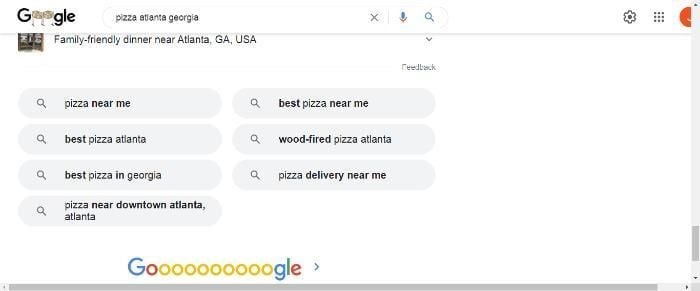
When you create content, you need to do the same: understand what the searcher wants through the keywords and terms they use, and develop content, offers, and lead magnets to match their demands.
The Basics of Search IntentYou should have a clear idea of search intent by now, and why it’s important you understand what your buyer is looking for.
Just so you get an even better picture of the difference between search intent and regular keywords, this image illustrates it well:
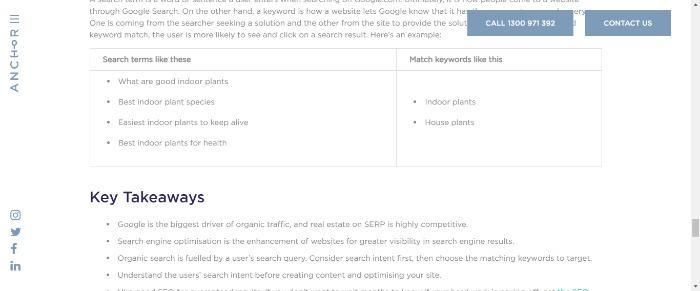
See? If you were in the gardening niche, you could write any number of articles around those search terms or offer a lead magnet detailing the best indoor plants.
There are numerous advantages to going beyond just keywords and aiming to understand the searcher’s intent.
As you see from my example in the intro, search intent has the potential to put your website in front of the searcher, increasing your chances of a click-through, a conversion, and, ultimately, perhaps a loyal customer. Then there are other benefits, like:
- You can improve your website’s search engine ranking: Search engines like Google use algorithms to rank websites based on how well they match the searcher’s intent. If you can create content that better meets people’s wants and needs, it’s likely to rank higher in the search results.
- You can better target your audience. Create relevant content to attract and potentially convert leads into customers and develop marketing strategies that are more effective.
- Search intent gives a better user experience: Give your prospect what they want, and they’re more likely to view you as an authority and keep coming back. With search intent, you can create more relevant content for your audience.
Here’s an important stat for you: 99 percent of search queries fall under the four main types of search intent.
That figure doesn’t come from me, that’s according to Brian Dean of Backlinko.com.
You can break intent down into four main categories: navigational, informational, transactional, and commercial.
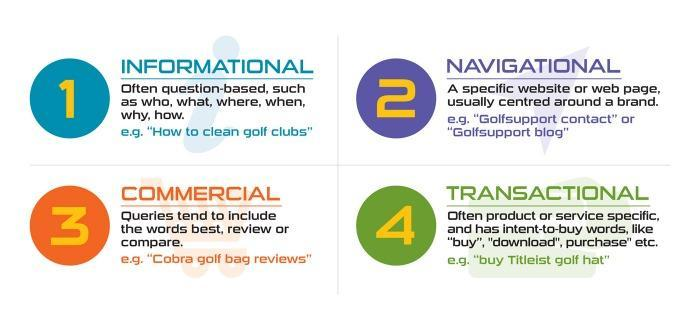
Let’s take a deeper look at the different types.
Navigational IntentThis is when search intent involves something specific and the user already knows the brand or website name. Everyone reading is likely familiar with navigational intent, and you’ve probably used it yourself before.
To satisfy this intent, users typically enter relevant keywords into a search engine, like ‘Adobe login’ ‘Adobe tutorial;’ or ‘Adobe subscription.’
By using relevant keywords, searchers ensure that they get the most accurate and useful results for their query.
Informational IntentThis type of search is what drives people to your website when they’re looking for information.
Informational intent is when someone is looking for information on a certain topic. They might not know what exactly they’re looking for, but they use keywords to guide their search; for example, you’d type something like ‘How to fix a flat tire.’
Usually, people search with this kind of intent when they’re at the beginning stage of the buying journey. For example, they may be starting a new home improvement project or researching a potential purchase.
Knowing how to target this type of search intent helps you improve your website’s ranking and bring in more traffic. Below are some tips to enable you to do just that.
- Ensure your website is well-organized and easy to navigate. People who search for information want to find it quickly and easily.
- Use keywords that are relevant to your topic to help with visibility and ranking. Help ensure that your site appears high on the search results pages.
- Answer the questions people commonly ask online; use Google’s ‘People Also Ask’ feature as a starting point.
- Finally, provide valuable content that meets the needs of your audience. Informational searchers are looking for accurate, reliable information, so make sure your website delivers!
Transactional intent means a person is online looking to actively buy a product or service.
Typically, they have a specific item in mind, and they may also be searching for the best deal. For example, they could be considering signing up for a subscription service or looking for a car part.
These types of searchers may be looking for further information, so they might use terms such as ‘review’ or product reviews, or they might search for listicle-style ‘top ten’ articles or comparison pieces to help inform their decision.
Commercial IntentCommercial intent is when someone is looking to learn more about a company or product before making a purchasing decision. Again, you can determine this by the keywords they use. For example, if someone searches for ‘ buy pizza near me,’ you know they’re in a buying/commercial mood.
They might also use words like ‘buy,’ ‘purchase,’ ‘deal’ and ‘discount.’ in their searches.
Of course, there are also hybrid queries that contain a combination of intentions, such as commercial and informational.
Why Is Search Intent Important For SEO?Times have changed.
Online visibility used to be all about keywords, and this often led to keyword stuffing, where site owners would overuse keywords to try and manipulate the search engines in their favor. Unfortunately, this often led to low-quality content dominating the SERPs, and these types of articles gave limited value to readers.
Then search got intelligent, which meant understanding search intent became a fundamental part of SEO. What are people looking for when they type a query into a search engine? Answer that question, and you can better optimize your content and website to match those needs.
That’s not to say keywords are no longer important, but you can’t afford to overlook your potential customers’ wants and needs. Integrating search intent into your content is how you can achieve that.
To further understand the role of search intent in SEO, you need to look no further than an extensive case study involving top SEO professionals, like James Dooley, Viola Eve, and Matthew Woodward.
These experts discussed search intent analysis, its importance, Google’s ever-changing algorithms, and the data surrounding these topics.
All the experts featured in the case study believe that search intent is ‘the foundation of content optimization’, equaling backlinks, technical SEO, and content when it comes to the search engines’ page evaluation process.
The case study concluded:
- Search intent is a ‘critical ranking factor,’ and the top SEOs create their strategies around it.
- Robbie Richards, the founder of Robbierichards.com, asserts that ‘Intent is the most important factor when it comes to prioritizing, and accurately qualifying your keyword opportunities.’
- Without search intent, your content isn’t pulling its weight. Or, as Viola Eve puts it, ‘Google’s job is to return the most relevant answer to a search query. If you understand what Google deems relevant, you can create a more targeted content briefing and SEO strategy and increase your chances of success dramatically.’
Finally, for this section, if you’re not using search intent yet, now might be a good time to do so.
With developments like artificial intelligence (AI), search is becoming increasingly sophisticated. For example, in a recent post, Google discussed Multitask Unified Model (MUM), and its potential for transforming search as we know it.
To save blinding you with science (or technology), here’s a simplified definition of MUM and how it assists search intent:
MUM is a search intent modeling technique that allows you to identify and group related search queries together.
This technique can help you understand what users are trying to accomplish when they search on your site. You can then use this information to improve your site’s search engine results pages (SERPs), create better content, and target ads more effectively.
In other words, MUM can understand the complexities of consumers’ needs, meaning searchers can complete tasks and get questions answered in fewer steps.
For instance, a search query may look like this:
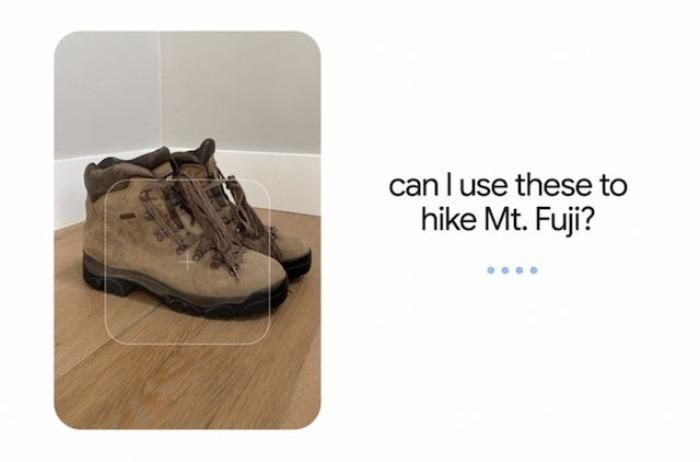
Then the search engine could provide an answer.
How To Learn Your Audience’s Search IntentHow do you determine your audience’s search intent? It can be a difficult task, but it’s important to get it right if you want to create content that’s effective in attracting and engaging your audience. Here are a few tips for learning your audience’s search intent:
1. Do some research into what keywords and phrases your target audience is using to find information online. Tools like Ubersuggest, Google Keyword Planner, and Google Trends can help you identify popular keywords and phrases related to your topic.
2. Pay attention to the types of questions your audience is asking on social media and online forums. This can give you some clues about the types of information they’re looking for.
3. Take a look at the SERPs and see what’s ranking high in Google for the keywords and phrases you’re targeting. Use the results to determine: The keywords they’re using in their search engines. Ensure you understand:
- The type of content they’re looking for (informational, etc.)
- The intent behind their search
- Their location and demographics
4. Use Google’s People Also ask feature. For example, if I type in ‘low carb diet,’ I get this:
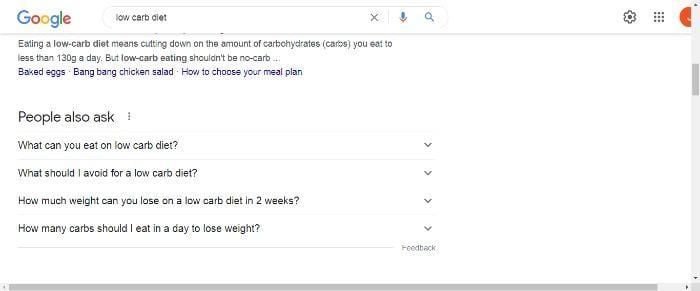
5. Use Google’s Autosuggest capabilities. For instance, if I start to enter ‘new car,’ I get
‘New car deals’
‘New cars 2022’
‘New car low price’
6. Another way to analyze search intent is to use Google’s related searches feature. This tool appears at the bottom of the search results page and shows you a list of other keywords that people are searching for.
7. Implementing a site search bar and functionality on your site. You can track this via GA. Using what your users are searching for on your website makes it easier for you to narrow down their search intent.
Putting Search Intent Into Action For Your ContentAs you can see from the examples in the above section, it’s pretty easy to write content around people’s search intent. Here’s how you can start putting search intent into action:
- Use keyword research to determine which keywords and modifiers your target audience is using to find information related to your topic. Once you know which keywords and phrases to target, you can add them throughout your content, in the title, in the body, and in the keywords section of your website.
- Create your website copy and content around your ideal customer’s search intent. For example, let’s consider ‘What can I eat on a low-carb diet?’ there is plenty of content you could create around the phrase.
- Ensure your CTA’s match your prospect’s search intent and their customer journey stage. For example, if you wanted to target searchers who want information about a low-carb diet, you’d write a series of articles around the topic and then invite people to sign up for a cheat sheet or eBook. Then when a lead signs up for the cheat sheet, you can start nurturing them through informational emails, etc., about the low-carb products you sell.
Now, let’s move on to content optimization.
Optimizing Content For Search IntentThe above section should give you some ideas for optimizing content, but there’s always more you can do.
First, use a tool. For example, Cognitive SEO has created a tool that lets you write keyword-optimized content around informational searches.
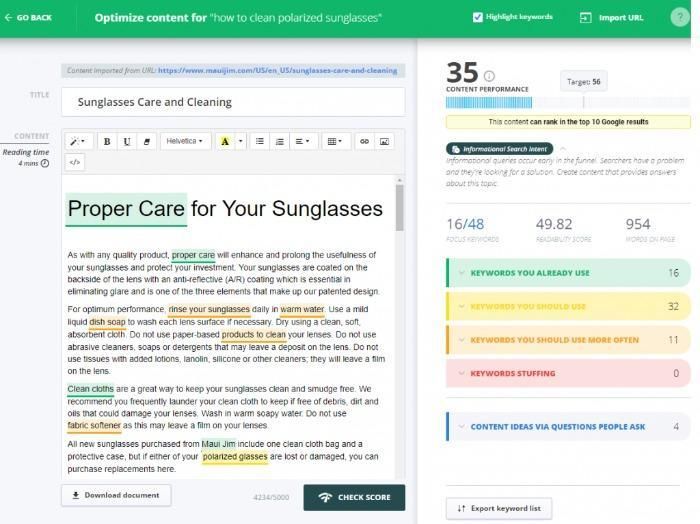
Then, add keywords to match the search intent.
For instance, to further optimize your site for navigational intent, you could include a relevant keyword to your title tags and meta descriptions, format your text properly and use images and videos that help illustrate your points.
With informational intent, you could offer freebies like a lead magnet and write engaging, informative content to persuade readers to take action. Additionally, you could use call-to-action buttons and other elements that encourage visitors to interact with your content.
For transactional intent, where your searcher is ready to buy, you need a frictionless landing page with a simple CTA like this example from Muzzle:
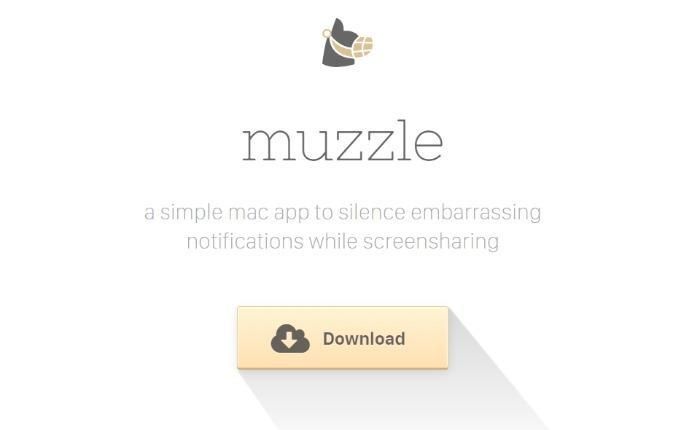
Another way to optimize for transactional search is by using structured data markup. This code tells search engines what type of content they have and can help them better understand the purpose of your page. Adding structured data markup can also help your content rank higher in search results.
FAQsSearch intent is the underlying reason why someone conducts a search. Understanding what people are looking for can help you create content that meets their needs and helps them find what they are looking for.
There are several ways to determine search intent, including viewing the SERPs for clues, using Google’s ‘People Also Ask’ feature, and using software tools.
Understanding search intent is key to providing the best user experience possible and there’s a simple reason why: search is consistently evolving and becoming increasingly sophisticated. Likewise, consumers’ demands change over time. Now, they want content that answers their questions and makes the buying decision easier, while understanding and addressing their pain points.
By considering what the user is looking for and tailoring your content to match, you can create a page that provides the answer they want.
When you can deliver the kind of content that meets searchers’ needs, you’re more likely to rank higher on Google and win customer confidence. In time, this can mean you’re more likely to engage your lead and ultimately convert them into a buyer.
Do you use search intent? How has it helped your business?
* This article was originally published here
* This article was originally published here







0 comments:
Post a Comment